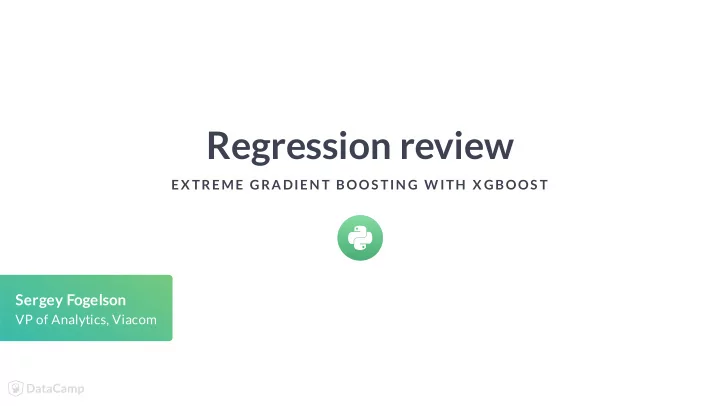

Regression review EX TREME GRADIEN T BOOS TIN G W ITH X GBOOS T Sergey Fogelson VP of Analytics, Viacom
Regression basics Outcome is real-valued EXTREME GRADIENT BOOSTING WITH XGBOOST
Common regression metrics Root mean squared error (RMSE) Mean absolute error (MAE) EXTREME GRADIENT BOOSTING WITH XGBOOST
Computing RMSE Actual Predicted 10 20 3 8 6 1 EXTREME GRADIENT BOOSTING WITH XGBOOST
Computing RMSE Actual Predicted Error 10 20 -10 3 8 -5 6 1 5 EXTREME GRADIENT BOOSTING WITH XGBOOST
Computing RMSE Actual Predicted Error Squared Error 10 20 -10 100 3 8 -5 25 6 1 5 25 T otal Squared Error: 150 Mean Squared Error: 50 Root Mean Squared Error: 7.07 EXTREME GRADIENT BOOSTING WITH XGBOOST
Computing MAE Actual Predicted Error 10 20 -10 3 8 -5 6 1 5 T otal Absolute Error: 20 Mean Absolute Error: 6.67 EXTREME GRADIENT BOOSTING WITH XGBOOST
Common regression algorithms Linear regression Decision trees EXTREME GRADIENT BOOSTING WITH XGBOOST
Algorithms for both regression and classi�cation 1 https://www.ibm.com/support/knowledgecenter/en/SS3RA7_15.0.0/ com.ibm.spss.modeler.help/nodes_treebuilding.htm EXTREME GRADIENT BOOSTING WITH XGBOOST
Let's practice! EX TREME GRADIEN T BOOS TIN G W ITH X GBOOS T
Objective (loss) functions and base learners EX TREME GRADIEN T BOOS TIN G W ITH X GBOOS T Sergey Fogelson VP of Analytics, Viacom
Objective Functions and Why We Use Them Quanti�es how far off a prediction is from the actual result Measures the difference between estimated and true values for some collection of data Goal: Find the model that yields the minimum value of the loss function EXTREME GRADIENT BOOSTING WITH XGBOOST
Common loss functions and XGBoost Loss function names in xgboost: reg:linear - use for regression problems reg:logistic - use for classi�cation problems when you want just decision, not probability binary:logistic - use when you want probability rather than just decision EXTREME GRADIENT BOOSTING WITH XGBOOST
Base learners and why we need them XGBoost involves creating a meta-model that is composed of many individual models that combine to give a �nal prediction Individual models = base learners Want base learners that when combined create �nal prediction that is non-linear Each base learner should be good at distinguishing or predicting different parts of the dataset Two kinds of base learners: tree and linear EXTREME GRADIENT BOOSTING WITH XGBOOST
Trees as base learners example: Scikit-learn API import xgboost as xgb import pandas as pd import numpy as np from sklearn.model_selection import train_test_split boston_data = pd.read_csv("boston_housing.csv") X, y = boston_data.iloc[:,:-1],boston_data.iloc[:,-1] X_train, X_test, y_train, y_test= train_test_split(X, y, test_size=0 random_state xg_reg = xgb.XGBRegressor(objective='reg:linear', n_estimators=10, seed=123) xg_reg.fit(X_train, y_train) preds = xg_reg.predict(X_test) EXTREME GRADIENT BOOSTING WITH XGBOOST
Trees as base learners example: Scikit-learn API rmse = np.sqrt(mean_squared_error(y_test,preds)) print("RMSE: %f" % (rmse)) RMSE: 129043.2314 EXTREME GRADIENT BOOSTING WITH XGBOOST
Linear base learners example: learning API only import xgboost as xgb import pandas as pd import numpy as np from sklearn.model_selection import train_test_split boston_data = pd.read_csv("boston_housing.csv") X, y = boston_data.iloc[:,:-1],boston_data.iloc[:,-1] X_train, X_test, y_train, y_test= train_test_split(X, y, test_size=0.2, random_state=123) DM_train = xgb.DMatrix(data=X_train,label=y_train) DM_test = xgb.DMatrix(data=X_test,label=y_test) params = {"booster":"gblinear","objective":"reg:linear"} xg_reg = xgb.train(params = params, dtrain=DM_train, num_boost_round=10) preds = xg_reg.predict(DM_test) EXTREME GRADIENT BOOSTING WITH XGBOOST
Linear base learners example: learning API only rmse = np.sqrt(mean_squared_error(y_test,preds)) print("RMSE: %f" % (rmse)) RMSE: 124326.24465 EXTREME GRADIENT BOOSTING WITH XGBOOST
Let's get to work! EX TREME GRADIEN T BOOS TIN G W ITH X GBOOS T
Regularization and base learners in XGBoost EX TREME GRADIEN T BOOS TIN G W ITH X GBOOS T Sergey Fogelson VP of Analytics, Viacom
Regularization in XGBoost Regularization is a control on model complexity Want models that are both accurate and as simple as possible Regularization parameters in XGBoost: gamma - minimum loss reduction allowed for a split to occur alpha - l1 regularization on leaf weights, larger values mean more regularization lambda - l2 regularization on leaf weights EXTREME GRADIENT BOOSTING WITH XGBOOST
L1 regularization in XGBoost example import xgboost as xgb import pandas as pd boston_data = pd.read_csv("boston_data.csv") X,y = boston_data.iloc[:,:-1],boston_data.iloc[:,-1] boston_dmatrix = xgb.DMatrix(data=X,label=y) params={"objective":"reg:linear","max_depth":4} l1_params = [1,10,100] rmses_l1=[] for reg in l1_params: params["alpha"] = reg cv_results = xgb.cv(dtrain=boston_dmatrix, params=params,nfold=4, num_boost_round=10,metrics="rmse",as_pandas=True,seed=123) rmses_l1.append(cv_results["test-rmse-mean"].tail(1).values[0]) print("Best rmse as a function of l1:") print(pd.DataFrame(list(zip(l1_params,rmses_l1)), columns=["l1","rmse"])) Best rmse as a function of l1: l1 rmse 0 1 69572.517742 1 10 73721.967141 2 100 82312.312413 EXTREME GRADIENT BOOSTING WITH XGBOOST
Base learners in XGBoost Linear Base Learner: Sum of linear terms Boosted model is weighted sum of linear models (thus is itself linear) Rarely used Tree Base Learner: Decision tree Boosted model is weighted sum of decision trees (nonlinear) Almost exclusively used in XGBoost EXTREME GRADIENT BOOSTING WITH XGBOOST
Creating DataFrames from multiple equal-length lists pd.DataFrame(list(zip(list1,list2)),columns= ["list1","list2"])) zip creates a generator of parallel values: zip([1,2,3],["a","b""c"]) = [1,"a"],[2,"b"],[3,"c"] generators need to be completely instantiated before they can be used in DataFrame objects list() instantiates the full generator and passing that into the DataFrame converts the whole expression EXTREME GRADIENT BOOSTING WITH XGBOOST
Let's practice! EX TREME GRADIEN T BOOS TIN G W ITH X GBOOS T
Recommend
More recommend